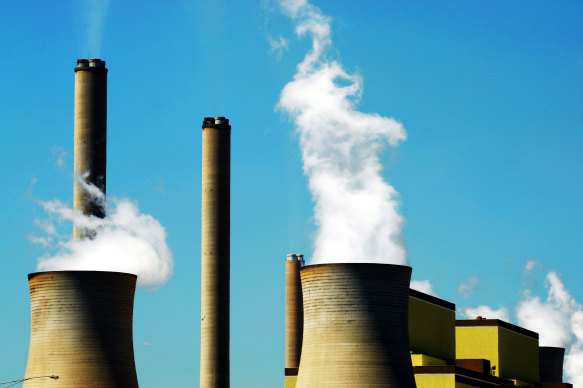By Mike Foley and Nick Toscano
Rising greenhouse emissions from burning fossil fuels are offsetting gains made by Australia’s clean energy transition, after coal and gas plants were forced into greater use to meet spiking electricity demand.
Between January and March this year, the nation’s emissions rose 0.6 per cent, the National Greenhouse Gas Inventory said.

Emissions from the electricity sector are rising.Credit: Jessica Shapiro
The preliminary figures released by the federal Energy Department on Friday underscore the significant challenges of Australia’s green transition amid revelations that carbon pollution cuts flatlined in the first half of the year.
Australia needs emissions to fall consistently between now and 2030 to meet its legislated emissions reduction target, with the deepest cuts to come from replacing polluting coal-fired power plants with clean renewable energy.
Emissions in the electricity sector rose 1.7 per cent in the March quarter. This increase was attributed to the huge demand for electricity as households switched on their air-conditioners to ride through heatwave conditions in NSW and Queensland, which required coal and gas plants to plug supply gaps after the sun went down.
In winter, between April and June, a prolonged stretch of cold weather collided with a rare wind power drought, limiting output from wind turbines and forcing gas-powered generators to meet peak demand.
Emissions in the electricity sector rose 1.3 per cent in the June quarter, the report said, due to an “increasing contribution of coal- and gas-fired generation to the total generation mix”.
Australia has achieved significant emissions reductions from its shift to cleaner power, which is considered one of the fastest of any country in the world.
Electricity sector emissions have declined over the long term, down nearly 29 per cent from their peak in 2009.
Renewables now account for 40 per cent of the mix, while the giant coal-fired generators that supply the bulk of the nation’s electricity are increasingly bringing forward their closure dates.
However, Australia’s flatlining emissions reduction exemplifies the size of the challenge for the Albanese government in meeting its climate targets.
To limit global warming as close as possible to 1.5 degrees – the level the Paris Agreement deems necessary to avert the worst effects of climate change – scientists say the world must reach a balance between the emissions it produces and those it removes from the atmosphere, known as “net zero” emissions.
Australia’s target of cutting emissions 43 per cent from 2005 levels by 2030 is legally binding, and is considered a critical stepping stone to reaching net zero by 2050.
The government is banking on the transformation of the nation’s coal-dominated electricity sector to deliver the bulk of emissions cuts.
It has hastened the rate of the rollout, with the share of renewables in the grid growing 25 per cent since it formed government in May 2022.
Climate Change and Energy Minister Chris Bowen said the figures showed Australia remained on track to meet its climate target, and accused the opposition of an “anti-renewables obsession”.
“Australia is lucky to be one of the sunniest places in the world, with some of the best solar and wind resources – harnessing them will ensure the clean, cheap, reliable and resilient energy system that Australians deserve,” Bowen said.
Opposition Leader Peter Dutton reignited the climate wars ahead of the next federal election, with a pledge to cancel Australia’s legally binding 2030 climate targets, and instead use taxpayers’ money to build seven nuclear plants, each potentially housing multiple reactors, between 2035 and 2050.
Dutton has said he supports the use of renewables in the energy mix, but has not specified what level of clean energy he would target for the grid.
The most recent projection from the Department of Climate Change, Energy and Water, released in November, showed emissions reductions are on track to comply with the 2030 climate target.
On top of renewable energy, the government has implemented policies to cut emissions by driving up electric vehicle uptake and to cut pollution from industrial users like processing plants, smelters and big miners.
The figures released on Friday showed emissions in the 12 months to June 2024 were 28 per cent below emissions in 2005, the baseline for the government’s climate target. Emissions fell 0.9 per cent compared with the previous 12 months in the year to June 2023.
Cut through the noise of federal politics with news, views and expert analysis. Subscribers can sign up to our weekly Inside Politics newsletter.